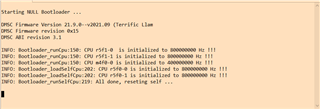Other Parts Discussed in Thread: UNIFLASH, SYSCONFIG
Hello TI,
I have two questions relating the custom flash driver topic.
I have managed to make custom flash driver work in 114 mode. And run the OSPI flash_io example from SDK
Now as mentioned in the related thread. I am trying to use jtag_uniflash program example to flash:
sbl_null_am243x-lp_r5fss0-0_nortos_ti-arm-clang.tiimage at offset 0x0
and
<myApplication>.appimage at offset 0x80000
It seems like I can program the flash just fine.However the program appImage still doesnt seem to start when switching to OSPI
and power cycling
So my first question is:
A) Is it necessary to activate the 444 mode to run bootloader etc. Or is it just for performance improvement?
SDK "Writing custom flash driver" mentions:
- Step 4 "Update the example.syscfg of the
ospi_flash_ioexample OSPI Flash IO using SysConfig GUI to select the new flash device you have added." - Step 5 "Similar to the
ospi_flash_ioexample, update the example.syscfg for OSPI bootloader (sbl_ospi) SBL OSPI and flash write"r
B) Is there any other action necessary then switching the flash in the sysconfig and rebuilding the JTAG_UNIFLASH and SBL_OSPI?
Thank you for your time and have a great day,
Dominik



